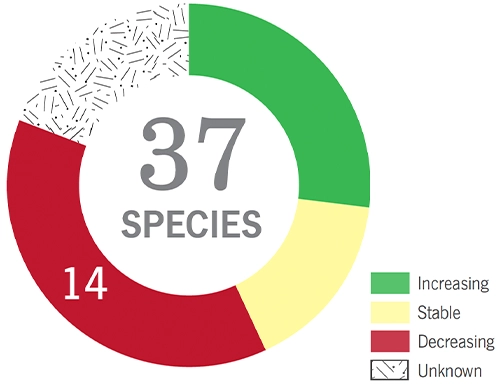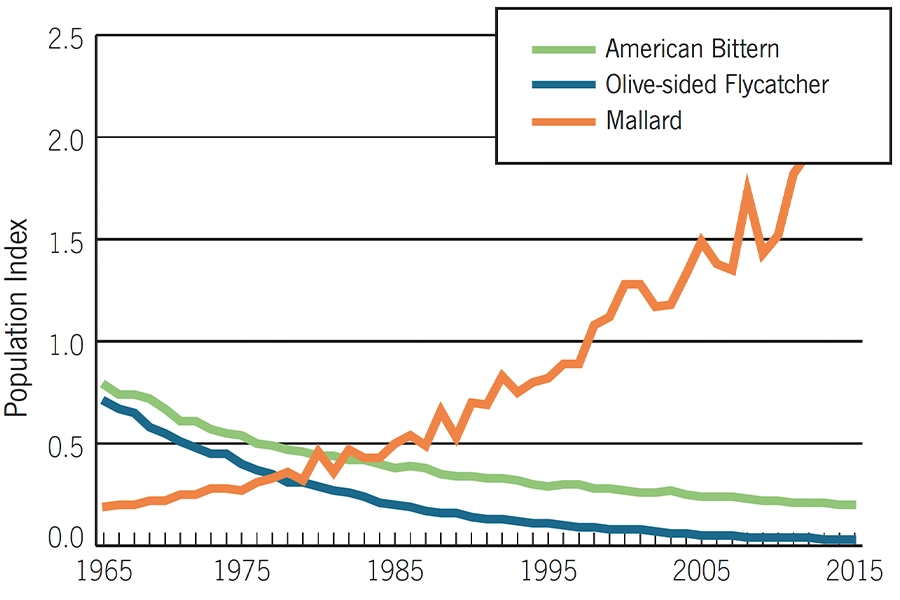This habitat includes a wide range of plant communities with persistent standing water and wetland vegetation, whether herbaceous (e.g., cattails, sedges, and grasses), shrubby, or some combination of the two. It can also include elements of floodplain forests, swamps, and peatlands depending on local vegetation. Wetland birds can be placed in two categories, with typical “marshbirds” occupying primarily cattail and sedge wetlands and other species restricted to shrub wetlands or their edges. Some birds, like Canada Geese, use a wide variety of wetland habitats, while others, notably Wood Duck, Osprey, and Great Blue Heron, nest in trees and forage in the surrounding wetlands.

American Black Duck
Pied-billed Grebe
Sora
Common Gallinule
Least Bittern
Northern Harrier
Olive-sided Flycatcher
Marsh Wren
Rusty Blackbird
Canada Goose
Wood Duck
Virginia Rail
Great Blue Heron
Eastern Kingbird
Swamp Sparrow
Red-winged Blackbird
Yellow Warbler

Many wetland birds, particularly the marshland species, are very secretive and live in often inaccessible habitat. Population trend data are still unknown for a fifth of species. The remainder are evenly split between increasing (e.g., Osprey and several waterfowl) and decreasing (many birds typical of shrubby wetlands such as Common Grackle and Yellow Warbler) species.
Dredging, filling, damming, or otherwise changing a wetland affects what plants can grow there, the amount of water it holds during which seasons, and the insects, snails, and other fauna that are present. These changes in turn affect wildlife use of the wetland. The effects of wetland alteration are likely to be most profound among species which require larger wetlands, such as American Bittern and Pied-billed Grebe. Although these impacts are regulated, and the regulatory goal is to minimize impacts, direct habitat loss is still a key threat facing birds in this habitat.
While invasive species are often introduced to a wetland when it is being modified for human purposes, birds and other wildlife may be sources of seeds or live plant fragments as well. When invasive species such as purple loosestrife and Phragmites reeds replace native vegetation and dominate a wetland, the habitat no longer supports typical marsh birds. The effects of other invasive species are less well known and likely will increase in the future.
Direct protection of wetlands and the adjacent uplands is the most important conservation action that can benefit wetland birds. This includes both minimizing human impacts and protecting against invasive species. Where wetland water levels are subject to management (e.g., at impoundments), it is important to maintain appropriate water levels that avoid both flooding and drawdowns during the nesting season (May through July) to protect nests and foraging habitat.
Better data on many marshbirds, especially the more secretive ones such as rails and bitterns, are needed to identify trends and factors affecting their populations.
Many threats faced by birds are tied to the habitats where they breed. Explore the habitats and learn more about each one’s characteristics, population trends, threats, and conservation actions.
Contact Headquarters

National Wildlife Federation Affiliate
Website By CleverLight
Information for the species profiles on this website was compiled from a combination of the sources listed below.
The Birds of New Hampshire. By Allan R. Keith and Robert B. Fox. 2013. Memoirs of the Nuttall Ornithological club No. 19.
Atlas of the Breeding Birds of New Hampshire. Carol R. Foss, ed. 1994. Arcadia Publishing Company and Audubon Society of New Hampshire
Birds of the World. Various authors and dates. Cornell Laboratory of Ornithology.
Data from the Breeding Bird Survey
Data from the Christmas Bird Count